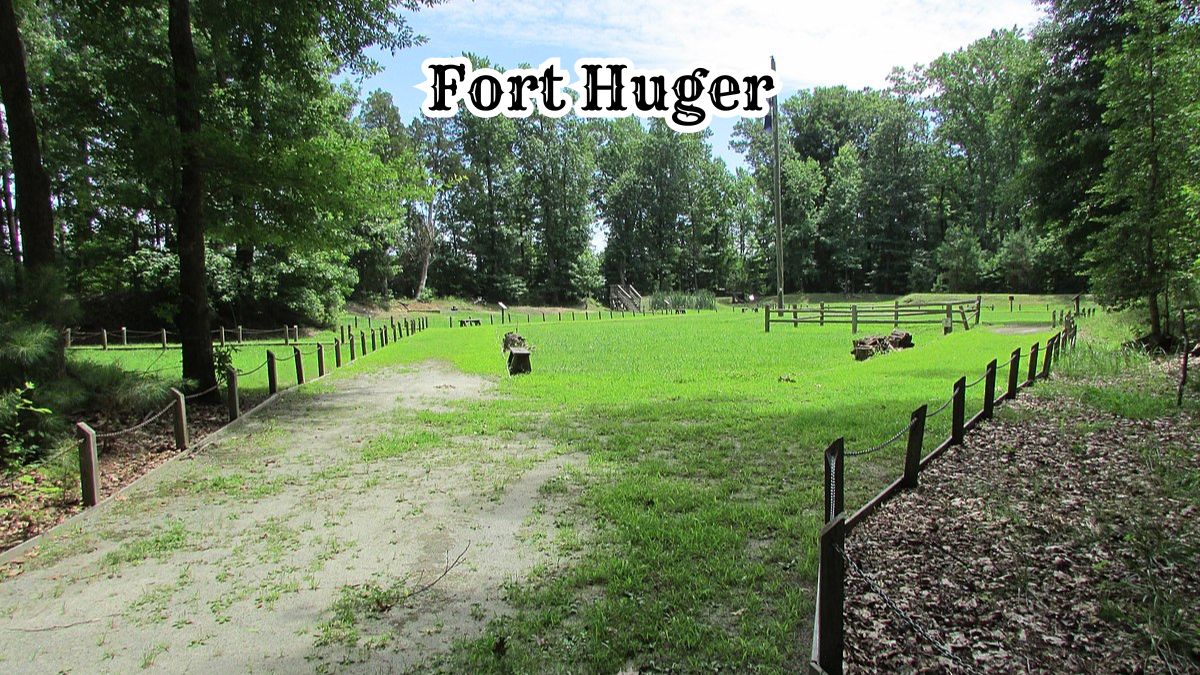Fort Huger, located in Isle of Wight County, is a significant site from the American Civil War era.
This historic fort was built to protect the Confederate capital, Richmond, and played a crucial role in coastal defense.
Visitors to Fort Huger can explore its well-preserved grounds and gain insights into Civil War military strategies.
The fort’s strategic importance cannot be overstated, as it provided a line of defense against Union naval forces.
Today, it offers a fascinating glimpse into the past, with earthworks and gun emplacements still visible.
History of Fort Huger (Virginia)
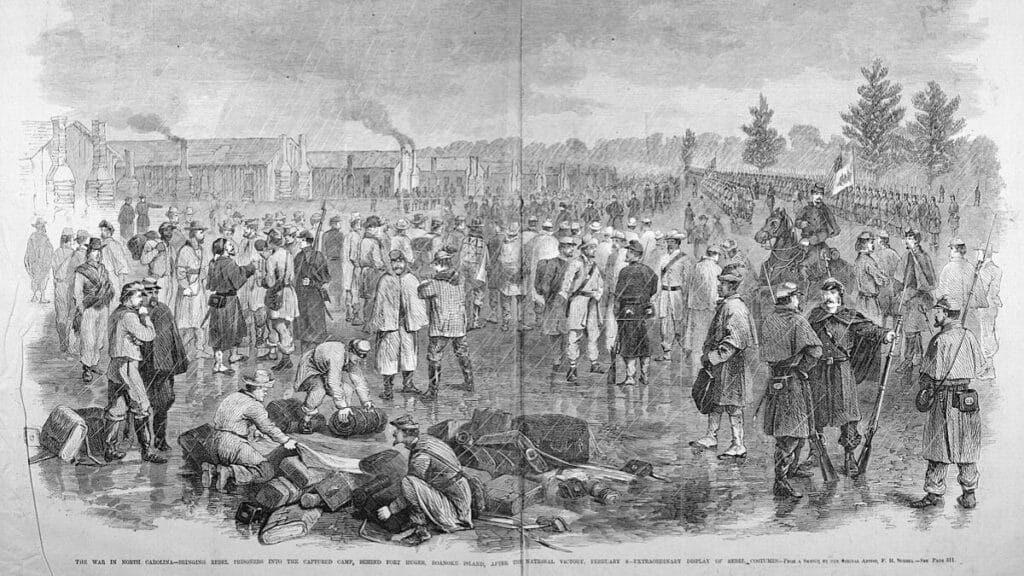
Due to its strategic location and its involvement with key military figures and units, Fort Hugar played a crucial role during the Civil War.
Its inclusion in the National Register of Historic Places underscores its importance in American history.
Civil War Importance
Fort Huger was instrumental during the Civil War, serving as a defensive stronghold for the Confederate Army.
It protected crucial supply lines and provided a strategic advantage along the James River.
The 5th Virginia Infantry Battalion manned the fort, which significantly defended the Department of Norfolk. This military positioning ensured that Union forces faced considerable resistance.
Strategic Location and Features
Fort Huger’s strategic location on the James River allowed it to control a vital waterway essential for transportation and supply routes during the Civil War.
Its robust design, crafted by Confederate Engineers and supported by the Confederate Engineer Bureau, included earthen bulwarks and artillery placements that fortified its defenses.
These features made it a formidable stronghold against Union assaults.
Key Figures
Several notable figures contributed to the history of Fort Hugar.
Confederate General Benjamin Huger was instrumental in its construction and strategic deployment, leveraging his military acumen to maximize its defensive capabilities.
Other key figures included members of the Confederate Engineer Bureau, who designed the fortifications and ensured they met the army’s tactical needs.
National Register of Historic Places
The historical value of Fort Huger has been recognized with its inclusion in the National Register of Historic Places.
This designation highlights its significance in the broader context of American history.
The fort’s preservation allows current and future generations to appreciate its role and the sacrifices made during the Civil War.
Its status on the register helps ensure ongoing efforts to maintain and protect this important site.
Fort Huger Design and Armament
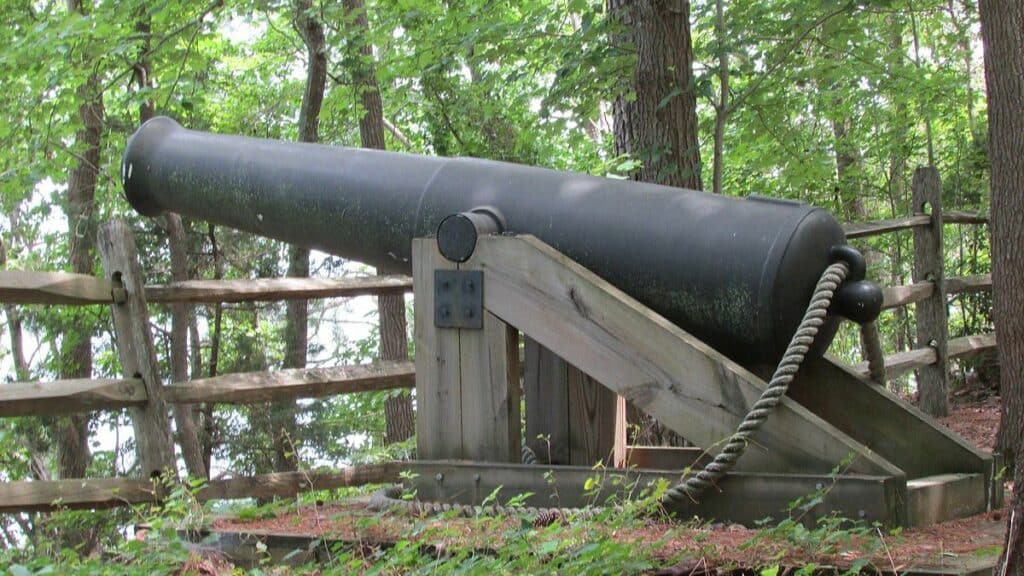
Fort Huger boasts intricate engineering, robust artillery installations, and formidable defensive structures. The fort’s design integrates strategic earthwork and a diverse range of cannons, enhancing its protective capabilities.
Engineering and Construction
Andrew Talcott, a prominent engineer, played a crucial role in the fort’s design.
The construction focused on resilient earthwork to absorb cannon fire and reduce structural damage.
The walls, composed of thick, compacted earth layers, provided an effective barrier against enemy assaults.
A series of underground passages enabled troops to move safely within the fort.
These tunnels connected various strategic points, providing logistical support and aiding in the fort’s overall defense.
This engineering marvel ensured both durability and tactical advantage.
Cannons and Artillery
The fort’s armament included an array of powerful cannons, including 8-inch Columbiads and 32-pounders, essential for offensive and defensive actions.
These cannons were strategically placed to maximize their range and impact.
Each artillery piece served a specific purpose.
The 8-inch Columbiads, capable of launching heavy projectiles over long distances, targeted enemy ships or distant fortifications.
On the other hand, the 32-pounders offered quicker reload times, providing rapid response during close-combat situations.
Artillery companies were responsible for operating and maintaining these formidable weapons.
Their expertise ensured the efficient functioning of the fort’s defenses, making Fort Hugar a formidable stronghold.
Defensive Capabilities
Fort Huger’s defensive capabilities were impressive.
The earthwork, as mentioned, played a central role in absorbing enemy fire.
Additionally, the fort’s strategic location along the James River Reserve Fleet provided a vital advantage, enabling it to control river access and prevent naval invasions.
Defensive structures included reinforced bastions and strategically placed gun emplacements.
These features allowed for a 360-degree field of fire, ensuring that no attacking force could approach without being subjected to intense bombardment.
Lookout towers provided excellent visibility, enabling early detection of enemy movements.
The fort’s design and armament seamlessly integrated offensive and defensive tactics, making it nearly impregnable.
Military Operations
Fort Huger played a crucial role in the Southern strategy, with significant engagements between Confederate and Union forces. Key military leaders and strategies shaped its operations during the Civil War era.
Confederate Defense Strategies
Confederate defense at Fort Hugar centered around fortifying positions to protect the Confederate Capital.
The Confederate forces, led by General Robert E. Lee and Brigadier General Lafayette McLaws, employed various tactical measures.
They constructed fortifications to withstand Union attacks and preserve their lines of communication.
Artillery placements were strategically positioned, and the troops were well-trained in defensive tactics, creating a formidable defense system.
Union Forces Engagement
Union forces, aiming to break the Confederate stronghold and access important targets like the Confederate Capital and Port Royal, focused their attacks on Fort Hugar.
Utilizing superior numbers and firepower, they systematically approached the fort’s defenses.
Union commanders directed their forces to exploit weaknesses in the Confederate lines.
These engagements often resulted in fierce battles, with both sides suffering significant casualties. The Union’s relentless pressure eventually led to breaches in the Confederate defenses.
Fort Boykin
Fort Boykin, near Fort Huger, was a critical support position for Confederate operations.
Located in Surry, Virginia, it provided additional defensive strength along the James River.
The fort’s artillery covered key river approaches, making it difficult for Union naval forces to advance.
Fort Boykin, in coordination with Fort Hugar, created a network of fortifications that enhanced the region’s defensive capabilities.
It played an essential role in the broader strategic plans of the Confederacy during the war.
Restoration and Preservation
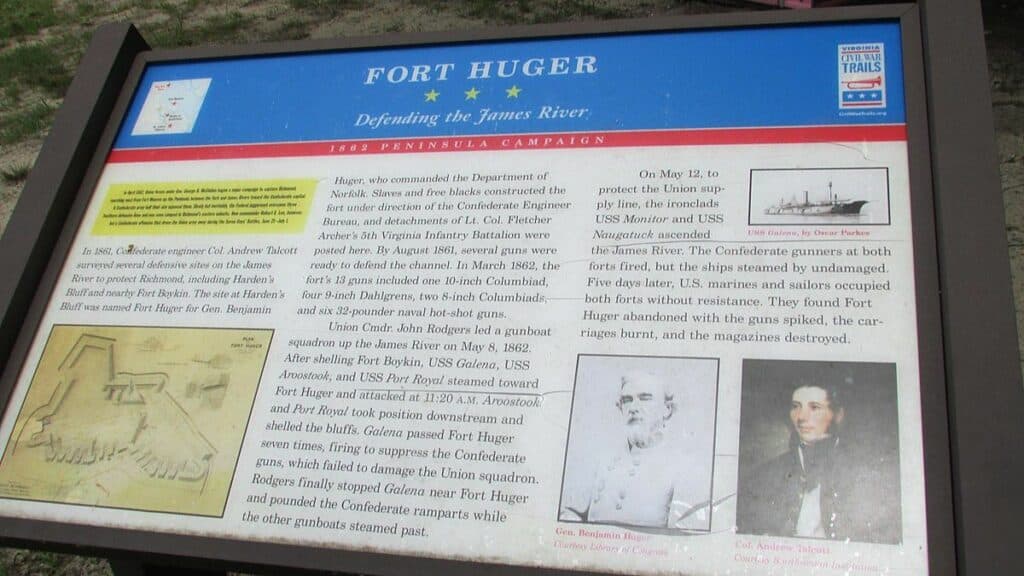
Fort Huger’s restoration and preservation have been ongoing efforts, focusing on renovation, historical interpretation, and clear markers and signage for visitors. These initiatives ensure the fort remains a significant historical site.
Renovation Efforts
The renovation process at Fort Huger started with structural stabilization. Critical areas were restored to prevent further decay.
Roofs and walls were reinforced using materials that matched the original construction.
Since April 5, 2024, a dedicated team has worked tirelessly to restore the fort.
They meticulously replaced damaged bricks and timber.
Preserving historical accuracy is vital, and this includes using period-appropriate restoration techniques.
Grants and donations have funded many renovations.
Community involvement has played a significant role in these efforts, with volunteers assisting in the restoration work.
Historical Interpretation
Historical interpretation at Fort Huger provides context for its role during its active years.
Re-enactments and interactive exhibits help visitors understand the fort’s daily life and military operations.
Interpreted aspects include key battles, military strategies, and soldiers’ lives there.
Educational programs for schools and history enthusiasts are regularly conducted, enhancing the learning experience.
These interpretations are based on thorough research. They ensure that Fort Huger’s importance is recognized both locally and nationally.
Marker and Signage
Clear and informative markers and signage are essential for a meaningful visitor experience at Fort Huger.
Civil War Trails Signage guides visitors through the historic site and offers detailed information about significant events and locations within the fort.
Markers indicate key areas such as battlegrounds, living quarters, and command centers.
Each marker includes historical data and anecdotes to enrich visitors’ understanding.
Signage is strategically placed to optimize the flow of tours and ensure no significant element is missed.
These signs are updated regularly to incorporate new research and discoveries. Their presence makes Fort Huger’s history accessible to all visitors, fostering a deeper appreciation for the site.
Visit Fort Huger

Fort Huger offers a range of visitor activities, including guided tours, historical reenactments on specific dates, and convenient low-cost parking. The location is easily accessible via Route 10 and Talcott Ter.
Scheduling and Tours
Fort Huger provides both Guided Walking Tours and Self-Guided Tours for visitors.
Guided Walking Tours are available daily, with experienced guides sharing detailed historical insights.
Tour times generally start every hour between 9 AM and 4 PM.
Self-guided tours allow visitors to explore the fort at their own pace and are accessible from dawn until dusk.
Tickets for the Guided Walking Tours can be purchased on-site or reserved by calling (757) 357-2291.
Seated maps are available that detail major points of interest within the fort.
Events and Reenactments
Fort Huger hosts numerous Events and Reenactments throughout the year to bring history to life.
Reenactment events usually occur on weekends and involve representations of the Civil War and Colonial Era.
These activities provide an engaging way for visitors to experience the fort’s historical significance.
Special events often include detailed programs, complete with live demonstrations and presentations.
Visitors are encouraged to check the official website or contact the fort’s administrative office for the latest event dates and times.
Early arrival is recommended, especially on event days, due to limited parking availability and high visitor turnout.
Location and Directions
Fort Huger is located at 15080 Talcott Ter, Smithfield, VA.
The site is easily accessible by car, mainly via Route 10.
Ample parking is available on-site, and it is free to visitors.
Maps and directions can be obtained either online or at the entrance gate.
For those using GPS, simply inputting the address should provide accurate directions.
If visitors have any questions or need assistance, they can contact the fort directly at (757) 357-2291.
The fort operates from dawn until dusk, giving ample time for visitors to explore the area fully.
Notable Personalities
Fort Huger has been influenced by several key figures who played significant roles in its history. Through their leadership and expertise, these individuals have contributed to the fort’s legacy.
Benjamin Huger
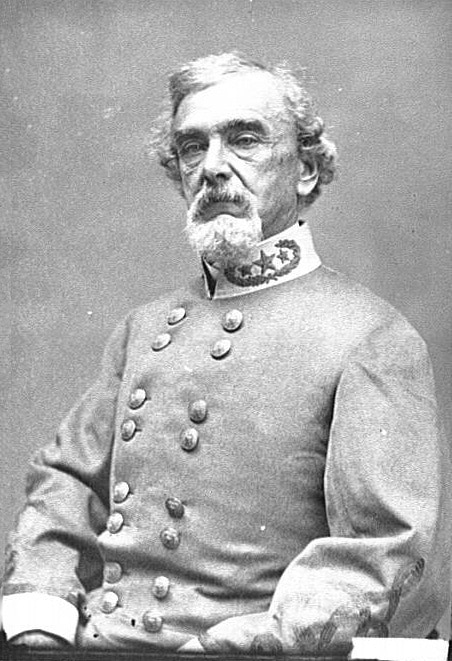
Born in 1805, Benjamin Huger served as a Confederate general during the Civil War.
He graduated from West Point in 1825 and was known for his engineering and artillery skills.
Huger played an important role in defending Charleston, South Carolina, showcasing his strategic insight.
His service also extended to overseeing ordnance production for the Confederacy, highlighting his technical expertise.
Despite criticisms of his command decisions, Huger’s contributions to military engineering and artillery were valuable.
Col. Andrew Talcott

Col. Andrew Talcott was an accomplished civil engineer and military officer.
Born in 1797, Talcott graduated from the United States Military Academy and significantly contributed to railroad and canal construction across the United States.
Robert E. Lee, a fellow engineer, worked alongside Talcott. This association underscores Talcott’s importance in military and civil engineering projects.
His work on the Chesapeake and Ohio Canal and various railroads was crucial to the nation’s infrastructure development.
Lt. Col. Fletcher Archer
Lt. Col. Fletcher Archer, a native of Virginia, served with distinction during the American Civil War.
Known for his leadership in the Confederate States Army, Archer was involved in several key battles.
He commanded the Archer’s Brigade and was known for his tactical abilities.
His role in the Confederate Army exemplified the courage and strategic thinking required during the tumultuous war.
U.S. Army Ordnance Officer
The role of a U.S. Army Ordnance Officer at Fort Huger was critical for maintaining the artillery and weapons systems.
These officers were responsible for procuring, supplying, and maintaining ordnance materials, ensuring that the fort’s defenses were always operational.
Their duties included inspecting weapons, overseeing repairs, and coordinating with other military branches.
The expertise of Ordnance Officers was vital for the effectiveness and readiness of the fort’s armaments.
Notable figures in this role contributed to Fort Huger’s military preparedness and operational success.
Cultural Impact
Fort Huger holds a significant historical and cultural role due to its influence on various communities and historical events.
Notably, it shaped life for both free Blacks and slaves and is closely linked to the Ghost Fleet of the James River.
Free Blacks and Slaves
Fort Huger had a complex relationship with the African American community.
For free Blacks, the fort provided a sense of security and community in a tumultuous period.
Many free Blacks worked at the fort in various roles, from laborers to skilled tradesmen.
Slaves also found the fort to be a pivotal location.
During the Civil War, the fort became a refuge for escaped slaves seeking protection and liberty.
They were often employed in constructing defenses and performing necessary labor, which granted them relative safety compared to life on plantations.
Ghost Fleet of the James River
The Ghost Fleet of the James River, also known as the James River Reserve Fleet, has an intriguing association with Fort Huger.
The fleet consisted of decommissioned naval and merchant ships stored in the river during and after World War II.
These vessels, visible from Fort Huger, became a part of the local landscape.
Some were scrapped, but many remained ghostly reminders of a bygone era.
The fleet significantly influenced the region’s maritime history and connected Fort Huger to broader naval and commercial activities on the James River.
Explore More: 10 Historic Forts in Virginia: An Epic Journey
Additional Information
This section provides detailed information about ironclads in the James River, precedents from the Mexican-American War, and the fortifications and earthworks associated with Fort Huger.
Ironclads in the James River
Ironclads played a crucial role in naval warfare on the James River during the Civil War.
These armored steam-powered warships proved to be game-changers in naval engagements.
The most famous ironclad battles include the USS Monitor and CSS Virginia clash.
Their design emphasized iron plating for protection against artillery, making them formidable against traditional wooden ships.
They were instrumental in blockading enemy ports and providing artillery support to ground forces.
Innovations in ironclad technology also influenced future naval engineering.
Their efficiency in riverine warfare underscored the James River’s strategic importance in controlling supply lines and influencing battle outcomes.
Mexican-American War Precedents
The Mexican-American War set significant precedents in military strategy and fort construction.
Engineers from the war later contributed to fortifications used during the Civil War.
One key precedent was the use of artillery and mobile fortifications.
Experiences from battles like Buena Vista and the Siege of Veracruz provided valuable insights.
Using fortified positions and earthworks demonstrated the effectiveness of well-prepared defensive structures.
These lessons were applied at Fort Hugar, incorporating robust designs to withstand prolonged sieges.
The conflict showcased the need for efficient supply lines and thorough surveys, which were critical to later military success.
Fortifications and Earthworks
Fort Huger’s fortifications and earthworks reflected the state-of-the-art military engineering of its time.
The fortifications combined traditional and innovative defensive techniques.
Constructed with thick earthen walls, the fortifications were designed to absorb and disperse artillery impact.
Bastions provided overlapping fields of fire, creating defensible angles.
Cannons were strategically placed to cover the surrounding area, ensuring a strong defensive posture.
The earthworks also included trenches and bombproof shelters, protecting soldiers from bombardments.
The design and layout offered protection and facilitated effective troop movements within the fort.
The combination of these features ensured Fort Hugar’s resilience to enemy assaults, highlighting the advanced military engineering practices of the era.

Cory is a website owner and content creator who enjoys fishing, history, coin collecting, and sports, among other hobbies. He is a husband and father of four.
Romans 15:4 For whatever was written in former days was written for our instruction, that through endurance and through the encouragement of the Scriptures we might have hope.

